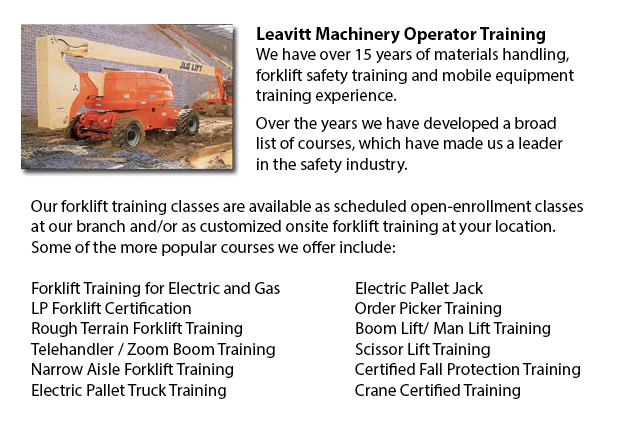
Vernon Boom Lift Safey Training - Boom lifts are a type of elevated work platform or aerial lifting device which are commonly utilized in construction, industry, and warehousing. Boom lifts can be utilized in practically any surroundings because of their versatility.
Elevated work platforms allow workers to get into work areas that would be unreachable otherwise. There is inherent risk in the operation of these devices. Employees who operate them have to be trained in the right operating techniques. Avoiding accidents is paramount.
Boom Lift Training Programs cover the safety aspects involved in using boom lifts. The program is best for people who operate self-propelled elevated work platforms and self-propelled boom supported elevated work platforms. Upon successfully completing the course, participants will be given a certificate by someone licensed to confirm the completion of a hands-on evaluation.
Industry agencies, federal and local regulators, and lift manufacturers all play a part in providing information and establishing standards to be able to help train operators in the safe utilization of elevated work platforms. The most essential ways in avoiding accidents associated to the utilization of elevated work platforms are the following: performing site assessments; inspecting machinery; and wearing safety gear.
Important safety factors when operating Boom lifts:
Operators must observe the minimum safe approach distance (or also called MSAD) from power lines. Voltage can arc across the air to be able to find an easy path to ground.
A telescopic boom should be retracted prior to lowering a work platform so as to maintain stability when the platform nears the ground.
People working from the platform of a Boom lift must tie off to guarantee their safety. lanyard and safety harness combinations should not be attached to any anchorage other than that provided by the manufacturer, never to other wires or poles. Tying off may or may not be needed in scissor lifts, depending on particular job risks, local regulations, or employer guidelines.
Avoid working on a slope which exceeds the maximum slope rating as specified by the manufacturer. If the slop exceeds requirements, then the machinery must be winched or transported over the slope. A grade can be measured without difficulty by laying a straight edge or board of at least 3 feet on the slope. Next a carpenter's level could be laid on the straight edge and raising the end until it is level. The per-cent slope is obtained by measuring the distance to the ground (the rise) and dividing the rise by the length of the straight edge. Then multiply by 100.
-
Vernon Heavy Equipment Training Programs
Vernon Heavy Equipment Training Programs - At whatever given construction site, there are often different types of machinery which are ready to be used. These heavy and light machines need both operators to run them and mechanics to fix them. Trainee... More -
Vernon Forklift Safety Training
Vernon Forklift Safety Training - People wanting work in industries that operate lift trucks should undergo a forklift safety training program before becoming a certified operator of a lift truck. There are a lot of ways to go about acquiring forklif... More -
Vernon Aerial Boom Lift Ticket
Vernon Aerial Boom Lift Ticket - Aerial platform lifts can accommodate various odd jobs involving high and tough reaching places. Normally used to complete regular preservation in structures with tall ceilings, prune tree branches, elevate heavy shel... More -
Vernon Manlift Safety Training
Vernon Manlift Safety Training - Manlift operators need to be cognizant and aware of all the potential dangers which are associated with particular classes of scissor lifts. They need to be able to operate the scissor lift in a way that protects not... More -
Vernon Forklift License
Vernon Forklift License - Obtaining a forklift certification or forklift license in North America will require the one training to carry out hands-on training in addition to classroom instruction. The provincial, federal and state regulatory bodies a... More -
Narrow Aisle Forklift, Order Picker, Electric Pallet Jack, Electric Pallet Truck Certification in Vernon
A pallet lift is a model of equipment dedicated in the transporting of pallets of many dimensions and weights. They can be utilized as an appendage for forklifts, cranes and other styles of heavy machinery or be applied on their own. Pallet hoists ar... More -
Vernon Manlift Operator Training
Vernon Manlift Operator Training - The aerial lift or manlift is a specialized kind of hydraulic platform that is designed to lift a person vertically giving it an alternate name of a vertical personnel lift. These machinery are widely utilized for a... More -
Vernon Crane Training Schools
Vernon Crane Training Schools - We have designed lots of programs for Mobile Crane Operation at our Crane Training Schools. These programs are recommended for the skilled operator who requires re-certification or certification, and for inexperienced... More

Forklift Certification Vernon
TOLL FREE: 1-888-254-6157
Vernon, British Columbia
forkliftcertificationvernon.com
Email Us
About Us


